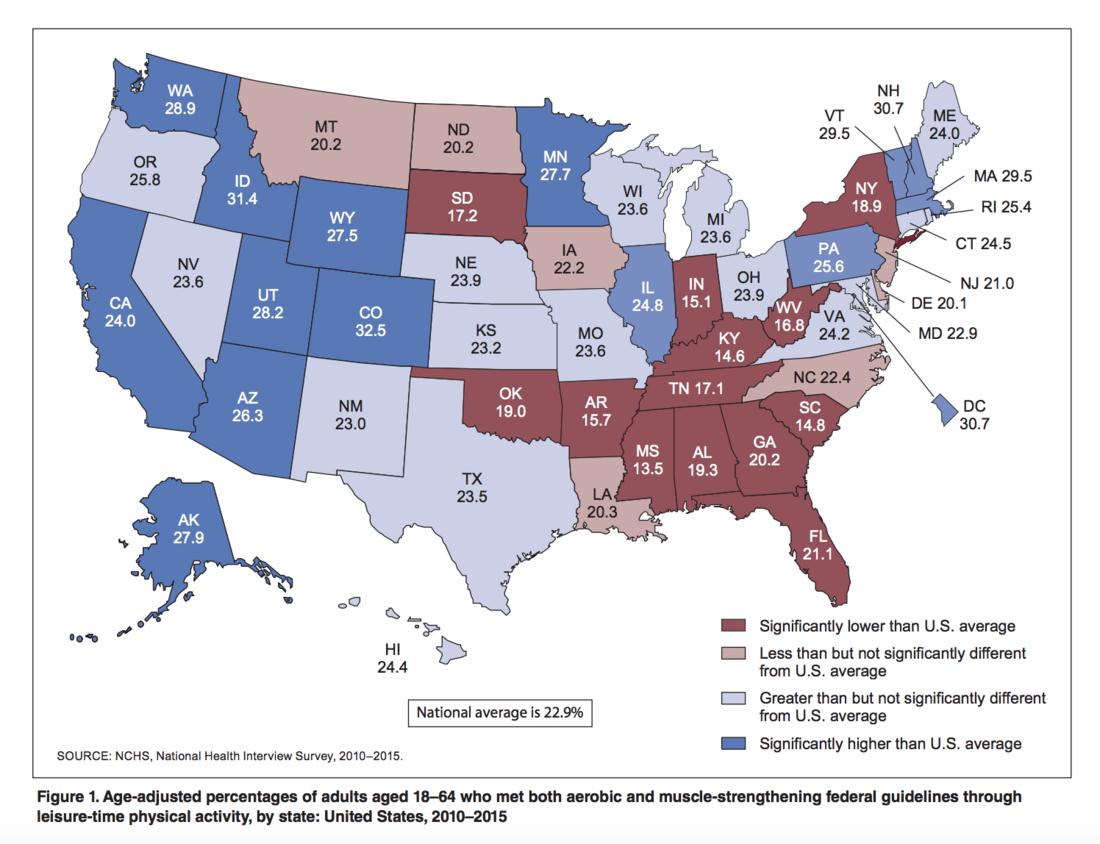大多數美國人缺少鍛煉

|
按照聯邦標準,只有不到1/4的美國人平時鍛煉足夠。 根據美國疾病控制與預防中心(CDC)6月28日發表的報告,在2010年至2015年間,18歲至64歲的美國成年人中只有22.9%的人在日常參與有氧運動和肌力訓練方面達到2008年政府指南的要求。 政府指南建議人們在業余時間至少每周參加兩次運動,具體來說人們應當“每周至少參加150分鐘的中等強度的有氧運動”或者“每周至少參加75分鐘高強度的有氧運動”,兩項交替也可。 按性別和所在州來細分的話,則差距很大。男性參與運動達到政府指南要求比例最高的州,是華盛頓特區的40.3%,最低是南達科達州的17.7%。 全美平均的話,男性達標比例27.2%。 女性參與運動達到政府指南要求比例最高的州,是科羅拉多州的31.5%,最低是密西西比州的9.7%。全美平均的話,女性達標比例18.7%。 |
Less than a quarter of Americans are getting enough exercise, based on federal standards. Only 22.9% of U.S. adults from 18 to 64 met 2008 guidelines for both aerobic and muscle-strengthening exercise between 2010 and 2015, according to new Centers for Disease Control and Prevention study on June 28. Government guidelines recommend leisure time exercise at least twice weekly. People should engage in “moderate-intensity aerobic physical activity for at least 150 minutes per week” or “vigorous-intensity aerobic physical activity for at least 75 minutes per week,” or any combination. Breaking down the numbers both by gender and by state offers a wide variance. The highest percentage of men meeting the government’s exercise guidelines was in Washington, D.C. at 40.3%.; the lowest for men was 17.7% in South Dakota. The national average for men was 27.2%. The highest percentage of women meeting the guidelines was in Colorado at 31.5%; the lowest was Mississippi at 9.7%. For women, the national average was 18.7%.?? |

參與運動人口比例圖。數據來源:CDC
|
從上圖可以看出,有14個州連同哥倫比亞特區,參與運動達標人數比例明顯高于全美平均水平,而有13個州明顯低于平均水平。 CDC指出,這份報告只涉及人們在業余時間參與鍛煉的調查,而在工作時間內的鍛煉,或者在上下班路上的鍛煉,就沒有考慮進去。該報告解釋說,從事體力工作,或者上下班途中就有鍛煉強度的成年人,一般不愿在業余時間再參與運動,所以這份評估不能涵蓋所有的運動量。報告推測,這一未被衡量的變量,即非業余時間的運動量,可能就是紐約州排名這么低的原因,要知道有6%的紐約人是徒步去上班的。 足夠的運動量是很重要的(不是說為了讓CDC的數據好看)。CDC列舉了鍛煉對于身體健康的8項重要好處:控制體重、減少心血管疾病風險、減少2型糖尿病風險、減少患癌癥風險、強健骨骼和肌肉、增進心理健康、提高完成日常活動的能力。 那么如何增加運動量,達到政府指南標準呢?CDC建議成人每周150分鐘“中等強度有氧運動”,可以是快走,而75分鐘“高強度有氧運動”,可以是跑步。除了有氧運動,每周兩次肌肉力量訓練也很必要,可以鍛煉所有主要的肌肉群。 關鍵是要去運動,瑜伽或者舉重,怎么都行。(財富中文網) 譯者:宣峰 |
As you can see from the map above, 14 states plus the District of Columbia have significantly higher averages compared to the national average while 13 states are significantly lower. The CDC notes that because the study only looks at leisure time exercise, exercise done for work, or even during a commute is not included. The study also explains that adults working in physically demanding jobs or engaging in physical activity as they commute to and from work may be less likely to engage in leisure time exercise. The measurements may therefore fail to account for total physical activity. The study speculates that this unmeasured variable — non-leisure time exercise — may be why New York ranks so low. Six percent of New Yorkers commute to work by walking. Getting enough exercise is important (and not just to boost these CDC numbers). The CDC lists eight important health benefits to exercise: controlling weight, reducing risk of cardiovascular disease, reducing risk of Type 2 diabetes, reducing risk for certain cancers, strengthening bones and muscles, improving mental health, and improving ability to move through everyday activities. So how can you up your exercise and meet the government guidelines? The CDC recommends that adults should engage in 150 minutes weekly of “moderate-intensity aerobic activity,” such as brisk walking, or 75 minutes of “vigorous-intensity aerobic activity” like running. In addition to this aerobic activity, people should do muscle strength exercises twice a week to work all of the major muscle groups. Anything from yoga to weight lifting qualifies. |













